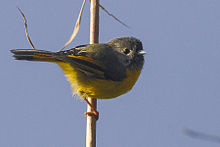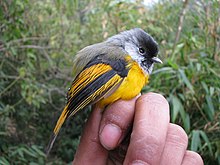Range and habitat
The golden-breasted fulvetta is found from central Nepal through Bhutan, northern India and Myanmar to western China and northern Vietnam. It is an altitudinal migrant, moving from breeding grounds at 2,000–2,800 m (6,600–9,200 ft) to foothills as low as 1,600 m (5,200 ft), and occasionally down to 1,300 m (4,300 ft), in the winter. [16]
Golden-breasted fulvettas are found in broad-leaved evergreen forests and montane bamboo where they forage at a low height for insects, moving in groups of as many as 30 individuals in winter, and often joining mixed-species foraging flocks. [15]
Conservation and threats
The International Union for Conservation of Nature (IUCN) lists the golden-breasted fulvetta as a species of least concern. Although its population has not been quantified and is thought to be declining, the decline is not thought to be precipitous, and its overall range is vast. [1] In recent times, there has been growing pressure on some populations, with people collecting them as a food source or as pets. [17]
Several species of feather mite have been described from specimens of the golden-breasted fulvetta including Timalinyssus grallator, [18] Neocalcealges chrysotis, Anhemialge lioparus and Resartor extraneus from China. [19] [20] [21]
This page is based on this
Wikipedia article Text is available under the
CC BY-SA 4.0 license; additional terms may apply.
Images, videos and audio are available under their respective licenses.


